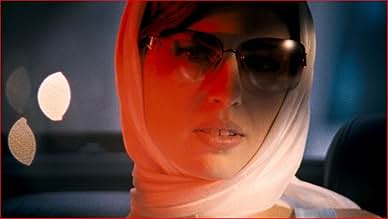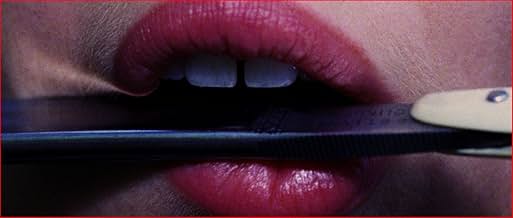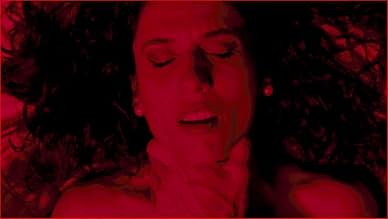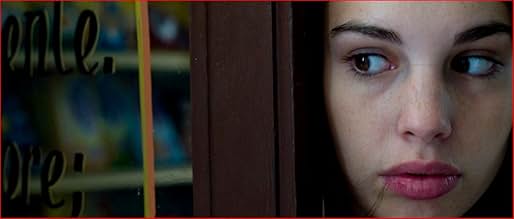IMDb-BEWERTUNG
6,1/10
6758
IHRE BEWERTUNG
Als junges Mädchen wurde Ana von Bildern des Todes und einer ominösen Gestalt in Schwarz gequält. Jetzt, als Erwachsene, wird sie erneut von schattenhaften, außerweltlichen Formen gequält.Als junges Mädchen wurde Ana von Bildern des Todes und einer ominösen Gestalt in Schwarz gequält. Jetzt, als Erwachsene, wird sie erneut von schattenhaften, außerweltlichen Formen gequält.Als junges Mädchen wurde Ana von Bildern des Todes und einer ominösen Gestalt in Schwarz gequält. Jetzt, als Erwachsene, wird sie erneut von schattenhaften, außerweltlichen Formen gequält.
- Regie
- Drehbuch
- Hauptbesetzung
- Auszeichnungen
- 7 Gewinne & 6 Nominierungen insgesamt
Charlotte Eugène Guibeaud
- Ana adolescente
- (as Charlotte Eugène Guibbaud)
Biancamaria D'Amato
- La mère
- (as Bianca Maria D'Amato)
Empfohlene Bewertungen
The childhood segment that opens this, I felt, was a ten-star movie, a superbly strange horror seen in bewildering fragments through the eyes of a child. What especially makes it is the dreamlike giallo humour, particularly on show in Argento's Inferno, of the character advancing oblivious no matter how nightmarish and Freudianly creepy things become, and no matter how clumsily they themselves behave.
At the end of this part, sadly, as if not quite knowing what to do with the brilliant potential it's found, the film dissolves into abstraction, followed by two rather more mundane sequences from adolescence and adulthood.
There's still a lot to enjoy here. I really like it, especially that, at a time when so much art-house film feels leadenly stuck in numb, muted-colour naturalism, this is utterly wild in its deployment of current film and editing tech. If you're doubting whether movies can really astonish visually after the demise of celluloid, take heart. There are whole new worlds to discover here and Amer, while also owing much to the past, points the way.
Too bad then it applies this sensibility to more and more boringly disorienting strings of extreme close-ups, especially of eyes, and, mixed in the the bravura imagery, some that is really cheap and tacky looking, like student video in which they've tried to dress things up by bleaching it out too much and adding a sepia tint.
It feels like desperate and probably fairly conscious padding, because, unfortunately, there isn't anywhere near enough substance in the later sections to carry the day. Given that the first segment so perfectly captures the strangeness of a child's perception, a huge opportunity seems to me to have been missed to do the same for adolescence and adulthood. The closest we get is an acknowledgement that teenagers are very interested in sex, and, well, duh.
At the end of this part, sadly, as if not quite knowing what to do with the brilliant potential it's found, the film dissolves into abstraction, followed by two rather more mundane sequences from adolescence and adulthood.
There's still a lot to enjoy here. I really like it, especially that, at a time when so much art-house film feels leadenly stuck in numb, muted-colour naturalism, this is utterly wild in its deployment of current film and editing tech. If you're doubting whether movies can really astonish visually after the demise of celluloid, take heart. There are whole new worlds to discover here and Amer, while also owing much to the past, points the way.
Too bad then it applies this sensibility to more and more boringly disorienting strings of extreme close-ups, especially of eyes, and, mixed in the the bravura imagery, some that is really cheap and tacky looking, like student video in which they've tried to dress things up by bleaching it out too much and adding a sepia tint.
It feels like desperate and probably fairly conscious padding, because, unfortunately, there isn't anywhere near enough substance in the later sections to carry the day. Given that the first segment so perfectly captures the strangeness of a child's perception, a huge opportunity seems to me to have been missed to do the same for adolescence and adulthood. The closest we get is an acknowledgement that teenagers are very interested in sex, and, well, duh.
Act 1 is brilliant - a terrifying, sensual, nightmarish homage to Dario Argento. Act 2 is boring filler. Act 3 has a nasty torture scene and is better than the second act, but still feels pointless.
When I included Amer in a short list of films I was eagerly anticipating in 2010, I wrote that I was looking forward to "ostentatious cameras that go on a discovery of psychosexual nightmares, a stylish violence, jazzy grooves". I'm a big fan of Italian genre cinema, especially gialli, for me they fulfill the needs comic-books do in others. When I say I'm a fan, I mean that when Stelvio Cipriani's song La Polizia Ha Le Mani Legate (originally part of Cipriani's score for Roma Violenta) finished playing in Amer's end credits, I rummaged through my cd collection to find it.
But, even as I was writing that a few months ago, Amer already had a reputation as more than a giallo film, "arthouse" people insisted, which intrigued me more. So, does Amer reward the giallo fan with the wink of film reference, or is the giallo only the trope of an expression intended for a different audience?
To go back to my appreciation for the giallo as comic book, it's the mentality of the colorful panel that appeals to me, the vivid bits of casual violence to strike a chord and be forgotten after the next page, the indulgence on something that reaches only as deep as the excitement it provides. To put so much effort or go through all the trouble for the pleasure of something momentary, this exaggeration is essentially the province of youth, where the fling of a few days burns with the passion of true love. In this sense, the giallo rejuvenates me.
That in mind, Amer is at once an apotheosis and a keelhaul of the panel, an overkill of shots capturing small details, of closeups of eyes or reflections or bits of the human anatomy. It's a world come alive through the senses, by a child overhearing conversations from behind closed doors, or a young girl feeling the first tingling of a booming sexuality in her skin. There's very little dialogue and this appeals to me, because the convoluted plots were always my least favorite aspect of the giallo.
But if Amer is not pushed forward by people talking, does it establish other means of communicating this story of sexual awakening and repression, the schism that follows from a child discovering a cruel world or a teenager being denied that discovery on her own?
I'll say yes, but with reservations. Still, what's important for me, is the tweaking of the filmed image to see is there another way to make cinema, the nature of an experiment whose results can only be appreciated in the future. Better said, if we peel a cabbage we get the core, but if we peel an onion? Some will say we get nothing, but we've done the peeling and we've transformed the onion, so can we really say that? The cinema of Amer is that peeling.
Two things particularly stand out for me here in this cinematic depiction of trauma.
One is the root of it, seen through the kaleidoscope of a child's awestruck imagination. A child's feverish nightmare shot in the otherworldly cyans and magentas of Mario Bava, where disfigured old men and strange hooded figures reach out to the camera. This is probably the most horrific part of the movie.
The other is the cause and effect of the teenage girl's sexual awakening. The directors explore this with a marvellous sense of exaggeration, of a complete fetishization of sexuality and the human body. When the young girl comes across a group of bikers, we get blurry closeups of chrome, of throats undulating or the trickle of perspiration, of buckles and boots. The girl approaches them almost solemnly, clinging to her short summer dress, with an air of fearful apprehension and the irrepressible instinct of a moth drawn to a flame. Before her discovery can be consumated, her overbearing mother shows up to slap her for the offense and take her away. Simple, crude some may say, but brilliant in getting a point across.
It's in the film's conclusion that we find the giallo lurking in the shadows of a ruined mansion, where the black-gloved hand of the killer slashes the dark. The directors give us the killing hand but with a twist, another contraption of the giallo.
What about the intended audience though? I feel that Amer will appeal more to fans of the sexual psychodrama of Repulsion, than the fan who will seek out a film like Amuck for the profound pleasure of watching giallo queens Barbara Bouchet and Rosalba Neri make out on the same bed. The lurid tradition of Sergio Martino is only honored in the selection of epochal musis by the likes of Bruno Nicolai, Morricone or Cipriani.
But, even as I was writing that a few months ago, Amer already had a reputation as more than a giallo film, "arthouse" people insisted, which intrigued me more. So, does Amer reward the giallo fan with the wink of film reference, or is the giallo only the trope of an expression intended for a different audience?
To go back to my appreciation for the giallo as comic book, it's the mentality of the colorful panel that appeals to me, the vivid bits of casual violence to strike a chord and be forgotten after the next page, the indulgence on something that reaches only as deep as the excitement it provides. To put so much effort or go through all the trouble for the pleasure of something momentary, this exaggeration is essentially the province of youth, where the fling of a few days burns with the passion of true love. In this sense, the giallo rejuvenates me.
That in mind, Amer is at once an apotheosis and a keelhaul of the panel, an overkill of shots capturing small details, of closeups of eyes or reflections or bits of the human anatomy. It's a world come alive through the senses, by a child overhearing conversations from behind closed doors, or a young girl feeling the first tingling of a booming sexuality in her skin. There's very little dialogue and this appeals to me, because the convoluted plots were always my least favorite aspect of the giallo.
But if Amer is not pushed forward by people talking, does it establish other means of communicating this story of sexual awakening and repression, the schism that follows from a child discovering a cruel world or a teenager being denied that discovery on her own?
I'll say yes, but with reservations. Still, what's important for me, is the tweaking of the filmed image to see is there another way to make cinema, the nature of an experiment whose results can only be appreciated in the future. Better said, if we peel a cabbage we get the core, but if we peel an onion? Some will say we get nothing, but we've done the peeling and we've transformed the onion, so can we really say that? The cinema of Amer is that peeling.
Two things particularly stand out for me here in this cinematic depiction of trauma.
One is the root of it, seen through the kaleidoscope of a child's awestruck imagination. A child's feverish nightmare shot in the otherworldly cyans and magentas of Mario Bava, where disfigured old men and strange hooded figures reach out to the camera. This is probably the most horrific part of the movie.
The other is the cause and effect of the teenage girl's sexual awakening. The directors explore this with a marvellous sense of exaggeration, of a complete fetishization of sexuality and the human body. When the young girl comes across a group of bikers, we get blurry closeups of chrome, of throats undulating or the trickle of perspiration, of buckles and boots. The girl approaches them almost solemnly, clinging to her short summer dress, with an air of fearful apprehension and the irrepressible instinct of a moth drawn to a flame. Before her discovery can be consumated, her overbearing mother shows up to slap her for the offense and take her away. Simple, crude some may say, but brilliant in getting a point across.
It's in the film's conclusion that we find the giallo lurking in the shadows of a ruined mansion, where the black-gloved hand of the killer slashes the dark. The directors give us the killing hand but with a twist, another contraption of the giallo.
What about the intended audience though? I feel that Amer will appeal more to fans of the sexual psychodrama of Repulsion, than the fan who will seek out a film like Amuck for the profound pleasure of watching giallo queens Barbara Bouchet and Rosalba Neri make out on the same bed. The lurid tradition of Sergio Martino is only honored in the selection of epochal musis by the likes of Bruno Nicolai, Morricone or Cipriani.
Yeah, I'm really not a fan of these 'style over substance' style movies. I saw this film's follow-up, THE STRANGE COLOUR OF YOUR BODY'S TEARS, before I saw this, so I had some idea of what to expect, but still this film's almost entire lack of storyline and coherent narrative was enough to finish me off. I get what the filmmakers are doing, and I'm a huge fan of the giallo genre, but this just smacks of pretentiousness and comes across as completely pointless.
AMER tells the visual story of a girl whose life is chronicled in various parts. She's subjected to a terrifying experience as a child, and then her perfect life as an adult is brought into jeopardy by the intervention of a mysterious stranger. There's no more to it than that; this is an entirely visual production, with thousands of cuts and edits designed to make the most beautiful experience ever.
The images are great, and the soundtrack is hugely evocative, but the whole thing lacks so much substance that it's a real chore to sit through and it seems to go on forever and ever. This is from a guy who's been enjoying the art films of the likes of Werner Herzog and Kim Ki-duk. But AMER is a case of the 'Emperor's new clothes'; the lights are on, and they're very pretty, but nobody's home.
AMER tells the visual story of a girl whose life is chronicled in various parts. She's subjected to a terrifying experience as a child, and then her perfect life as an adult is brought into jeopardy by the intervention of a mysterious stranger. There's no more to it than that; this is an entirely visual production, with thousands of cuts and edits designed to make the most beautiful experience ever.
The images are great, and the soundtrack is hugely evocative, but the whole thing lacks so much substance that it's a real chore to sit through and it seems to go on forever and ever. This is from a guy who's been enjoying the art films of the likes of Werner Herzog and Kim Ki-duk. But AMER is a case of the 'Emperor's new clothes'; the lights are on, and they're very pretty, but nobody's home.
Leaving viewers in the dark about the true inclination of a piece is commonplace in Art Cinema. I do agree that most mainstream films now are over explained and blatant with whatever plot device is being utilised. However, while i think it's good for the viewer to give a little of themselves to work at understanding a director's vision this was a little much.
The visuals are beautiful. Some of the little touches exquisite (the way the teenage Ana hypnotically chews on a strand of her hair was simultaneously abhorrent and alluring) I'm sure there is an intricate back-story here with allusions to Sigmund Freud etc (from what i've heard there is a portrait of him in the house, however i didn't see it) but i'm not hugely interested in discovering what it is. A little explanation can make all the difference. Some connection with the audience would have helped this piece along.
In the end, the plot made little difference. Its slightness WAS the film for me. I enjoyed the inspired jump-cuts and the obsession with body hair and sexual gratification. I was amused and disturbed. That's fine. But the film used these devices to the point of saturation. Overkill. Egotism.
I may be missing the point here, so be it. This film stands well as a piece of visual art. The vivid blue Mediterranean, the dark haired women, the gorgeous cinematography in general. But it is missing something as a film and thus with narrative. It would have worked FAR better as a short 15 minute piece.I would like to say i'd re-watch this and get to grips with what the director is trying to say, but that would be a lie. Certainly this film is nothing like the Giallo films of Fulci and Argento that i have seen so far in my admittedly limited viewing.
The visuals are beautiful. Some of the little touches exquisite (the way the teenage Ana hypnotically chews on a strand of her hair was simultaneously abhorrent and alluring) I'm sure there is an intricate back-story here with allusions to Sigmund Freud etc (from what i've heard there is a portrait of him in the house, however i didn't see it) but i'm not hugely interested in discovering what it is. A little explanation can make all the difference. Some connection with the audience would have helped this piece along.
In the end, the plot made little difference. Its slightness WAS the film for me. I enjoyed the inspired jump-cuts and the obsession with body hair and sexual gratification. I was amused and disturbed. That's fine. But the film used these devices to the point of saturation. Overkill. Egotism.
I may be missing the point here, so be it. This film stands well as a piece of visual art. The vivid blue Mediterranean, the dark haired women, the gorgeous cinematography in general. But it is missing something as a film and thus with narrative. It would have worked FAR better as a short 15 minute piece.I would like to say i'd re-watch this and get to grips with what the director is trying to say, but that would be a lie. Certainly this film is nothing like the Giallo films of Fulci and Argento that i have seen so far in my admittedly limited viewing.
Wusstest du schon
- WissenswertesShot on 16mm film and then blown up to 35mm to recreate the grainy effect of 1970s exploitation movies.
- VerbindungenReferenced in Lost in Vienna, Austria (2013)
Top-Auswahl
Melde dich zum Bewerten an und greife auf die Watchlist für personalisierte Empfehlungen zu.
- How long is Amer?Powered by Alexa
Details
- Erscheinungsdatum
- Herkunftsländer
- Offizieller Standort
- Sprache
- Auch bekannt als
- Amer - ein Albtraum aus Angst und Begierde
- Drehorte
- Produktionsfirmen
- Weitere beteiligte Unternehmen bei IMDbPro anzeigen
Box Office
- Budget
- 880.000 € (geschätzt)
- Laufzeit1 Stunde 30 Minuten
- Farbe
- Sound-Mix
- Seitenverhältnis
- 2.35 : 1
Zu dieser Seite beitragen
Bearbeitung vorschlagen oder fehlenden Inhalt hinzufügen

Oberste Lücke
By what name was Amer - Die dunkle Seite deiner Träume (2009) officially released in Canada in English?
Antwort




















